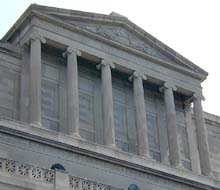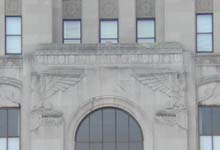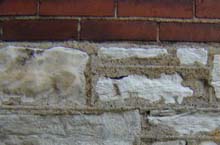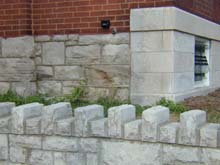




Limestone in St. Louis Buildings
Many of the city's major landmarks are made of limestone.
The Old Cathedral
Unlike some other kinds of limestone, St. Louis limestone turns almost white when it is exposed to the weather.
The Old Courthouse
This is limestone painted white.
 The Masonic Temple on Lindell.
The Masonic Temple on Lindell.
 South Side National Bank building at Grand and Gravois.
South Side National Bank building at Grand and Gravois.
Limestone is also found throughout St. Louis neighborhoods.
 In St. Louis' neighborhoods, you most often see limestone at buildings' foundations. The foundation is the base on which the rest of the structure rests. Because of its strength, availability and relative cheapness, local limestone was a good choice.
In St. Louis' neighborhoods, you most often see limestone at buildings' foundations. The foundation is the base on which the rest of the structure rests. Because of its strength, availability and relative cheapness, local limestone was a good choice.
 This building has three different uses of limestone! The foundation stones at the front of the building are smoothed and laid in neat courses for a more finished look; at the side, though, the stones are left rough and are different sizes. The retaining wall in front is pretty unusual, don't you think?
This building has three different uses of limestone! The foundation stones at the front of the building are smoothed and laid in neat courses for a more finished look; at the side, though, the stones are left rough and are different sizes. The retaining wall in front is pretty unusual, don't you think?
 Wood
Wood
|
 Clay
Clay
|
 Stone
Stone
|
 Identify It!
Identify It!
|
More About Stone
Limestone
Where Does It Come From?
Limestone in St Louis Buildings
Granite
Where Does It Come From?
Granite in St Louis Buildings
Marble
Where Does It Come From?
Looking at Marble in St Louis
Related Links
Old Cathedral
Masonic Temple
South Side National Bank

people
• structures • events
• sources • home
about
historic preservation• new entries• 4 kids only• map it!
This
site was made possible by: the City of St. Louis Planning and Urban Design Agency and
the City of St. Louis Community
Information Network.
This site was funded in part by Federal funds administered by the Missouri State Historical Preservation
Office, Missouri Department of Natural Resources, The National Park Service, and the U.S. Department of the Interior.
Version 1.0